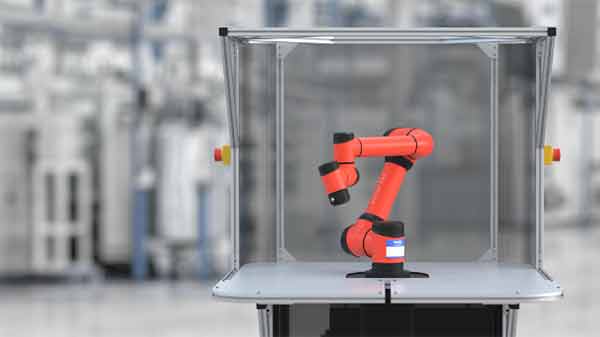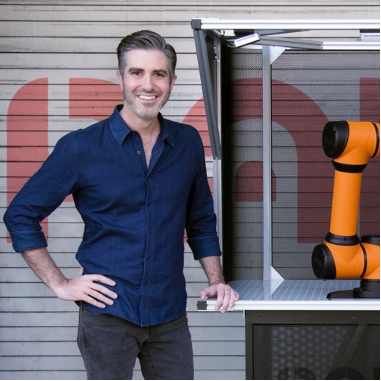Robots as a service will transform small factory manufacturing in the U.S. and become the hero of 2022.

By Jordan Kretchmer, CEO, Rapid Robotics
Humble robots will transform manufacturing in 2022 and beyond. They won’t be the fancy dancing robots made famous on 60 Minutes. And they’ll be even less glamorous than a home vacuum robot. The hero of 2022 will be simple robotic arms that utilize AI and are pre-trained to do repetitive, ubiquitous tasks in small factories. While their jobs won’t be glamorous, they will be responsible for resurrecting manufacturing in the United States, solving the supply chain as well as the labor crises we’re experiencing today.
This might sound like a tall order for a six-axis robot, but it becomes possible when you consider:
The pandemic heightened the need for U.S. companies to reduce their dependence on overseas manufacturers for basic components. Bringing this business back to America is the obvious solution, but robots are essential for making stateside manufacturing feasible again.
New developments in automation are allowing small manufacturers to meet demand while helping with American competitiveness. And the entry of robots as a service — RaaS is doing with robots what SaaS did with software — finally makes the prospect of a robot more affordable, accessible, and flexible enough for small manufacturers than ever before.
First, let’s diagnose what’s wrong with the current supply chain. We cannot make cars, refrigerators, and X-ray machines without first making all the small parts to go into those products. NPR did an entire report on “How a single missing part can hold up $5 million machines and unleash industrial hell.”
Products can be held hostage by a tiny part that isn’t economical to make in the U.S. and was outsourced to overseas factories. That means the little widgets you can’t do without have to travel by container ships across oceans and you’re out of luck if there’s any trouble along the way or at the port. The price volatility of overseas production is also disruptive to what would otherwise be consistent margins.
The good news is that 80 percent of all manufacturing in the U.S is done in small facilities where people run machines like injection molders, pad printers, and lathes. This means that the basic infrastructure for component production is already here. They’re already making the little parts that go into the products sold by larger companies.
The bad news is that the existing machinery still require human operators. And fewer people are willing to do such repetitive and low pay work today than at any point in history. That means jobs go unfilled and the cost to hire and retain human operators has gone up almost 20% just in the last 18 months. Just to meet today’s demand in the US, manufacturers would have to hire over 800,000 new operators, and no one is applying.
The bad news continues: Even if manufacturers could find all the workers they need, the human-operated machines can never produce enough components. Yet automation has been out of reach for small factories because of cost and the unreliability of robots in the traditional sense. There are lots of rooms filled with decommissioned robots that didn’t work as promised or were too expensive to have reprogrammed, which makes any small factory owner skeptical of any promises made by robotics companies and the system integrators who historically have been required to install them at an exorbitant cost.
Fortunately, there’s more good news to report. All those small manufacturers already in the U.S. are starting to discover robots as a service. RaaS promises smart, functional, affordable robots that a company can subscribe to for a monthly fee. The robots are pre-trained on the common functions at any given factory. There isn’t expensive or unwieldy integration because the robots arrive ready to work. The subscription service handles all support issues.
Due to the recurring business model, RaaS companies also have the ability to provide ongoing maintenance and support, which completely removes the burden of having to oversee the arms.
A better supply chain is coming to America with robots making the small components we need right here at home.
While we can expect the supply chain to remain in limbo in 2022, automation is how we’ll solve bottlenecks like labor shortages that have been plaguing the industry for the last decade, and were made far worse by the pandemic. The RaaS model will apply the efficiencies of the SaaS model to produce solutions that streamline the use of robotic automation for tasks that were previously too expensive to automate.
The hardware it takes to build robots has come down in price in recent years. Now the biggest question is how much does it cost to train a robot? And how often does it need to be retrained?
RaaS lets factories rent pre-trained robots for a couple thousand dollars a month that have AI and machine vision included. They don’t need integration and can work 24/7 on common tasks like cutting, molding, and labeling. They even get smarter over time as the subscription service provides regular updates based on real-world needs.
Gone are the days when manufacturers had a sea of robots in warehouses that did specific jobs and became obsolete when the jobs were completed. Renting robots means factories won’t have to invest in robots that will eventually sit around and collect dust. Every RaaS robot serves a current need without ever turning into deadwood, and allows for the kind of flexibility that small and mid-sized manufacturers need in order to grow their businesses.
Another upside is that one human machine operator can supervise a whole fleet of robots. This allows manufacturers to move existing staff onto more complex, rewarding tasks. And the boosted productivity means a factory can take on more component work at far higher margins rather than let an overseas competitor have it.
While the reliance on overseas factories won’t change overnight, change is coming. The speed of change will depend on the product. Some will become robot-made at home faster than others. But before long, the winner will be small-to-midsize manufacturers in the United States. They will be in a much more robust and competitive position than in generations.
2022 is the year that hope is realized in a rented robot.

Jordan Kretchmer is the co-founder and CEO of Rapid Robotics. Prior to Rapid, Jordan Kretchmer was the Founder and CEO of Livefyre, which became the leading SaaS content management platform for connecting businesses to their customers and the media to their readers. Jordan led Livefyre through acquisition by Adobe in 2016.
Now, at Rapid Robotics, he’s brought the economic benefits of SaaS to the business of manufacturing—and in doing so has cracked a multi-billion dollar problem for American factories. He looked for an urgent problem, found the solution and then proved the solution would scale just a few months after founding the business.
Scott Ellyson, CEO of East West Manufacturing, brings decades of global manufacturing and supply chain leadership to the conversation. In this episode, he shares practical insights on scaling operations, navigating complexity, and building resilient manufacturing networks in an increasingly connected world.